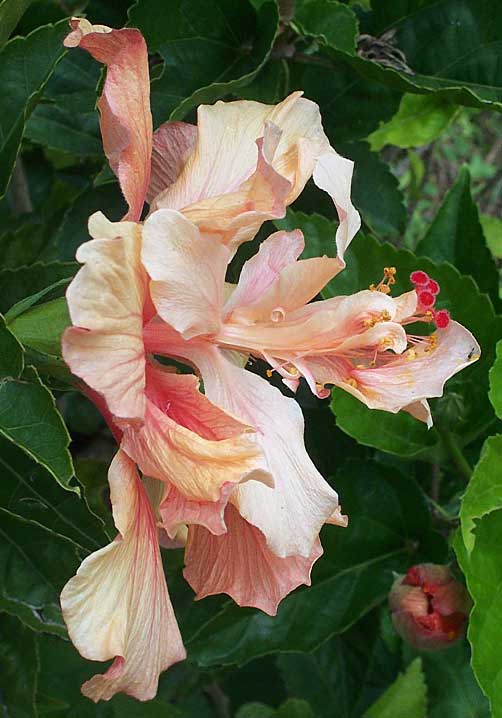Excerpts from Jim Conrad's
Naturalist Newsletter
from the October 29, 2007 Newsletter issued from Yerba Buena Clinic just outside Pueblo Nuevo Solistahuacan, Chiapas, MÉXICO
about 1740 meters in elevation, ± LAT. 17° 11' 27"N, LONG. -92° 53' 35"W
INÉS'S MESSED-UP ROSE-OF-CHINA
Take a look at a flower on one of Inés's Rose-of-Chinas below.

Rose-of-Chinas aren't roses at all, but rather Hibiscuses, specifically HIBISCUS ROSA-SINENSIS, and the species probably did originate in China. They're such gorgeous plants that now they're grown worldwide in hot climates, and have been bred into many horticultural forms.
In fact, the blossom in the picture is from a plant whose genes plant breeders have tinkered with in order to get a flashier blossom than those of standard Rose- of-Chinas. Flowers of normal Rose-of-Chinas have their male stamens mounted on a cylinder, or column, around the female style, as shown in the top, left photo at www.backyardnature.net/fl_hibsc.htm.
What's happened with Inés's plant is that genetic manipulation has caused stamens on the blossom's staminal column to form petals instead of stamens. In the picture, notice how on the column arising in the flower's center and pointing to the right stamens are mingled with petals, and notice that some of those petals have brownish, lumpy areas along one of their sides. Those brownish, lumpy spots are "almost- stamens." One side of the petal is pure petal but the other side is almost a stamen.
It turns out that, because early in the evolutionary history of flowering plants petals arose from primitive stamens, much of the genetic information that makes a petal is the very same information used to create a stamen. Thus plant breeders just needed to fiddle with genes producing stamens on the normal Rose-of-China's staminal tube and, presto, a blossom with more flower petals than normal resulted.
Plant breeders use this trick a lot, probably most successfully among the roses. At the bottom of my page at www.backyardnature.net/fl_roses.htm you can see a spectacular instance of a rose stamen with one side of its anther normal, but the other side clearly trying to be a petal!
I don't like "double-flowered" varieties of anything. Nature spent millions of years evolving blossoms to be the unique things they are, and now humans are re-evolving them just for bigger, gaudier flowers. Now not only hibiscuses but also buttercups, camellias and other completely unrelated plants produce similarly bright and colorful, but monotonously same-looking blossoms.